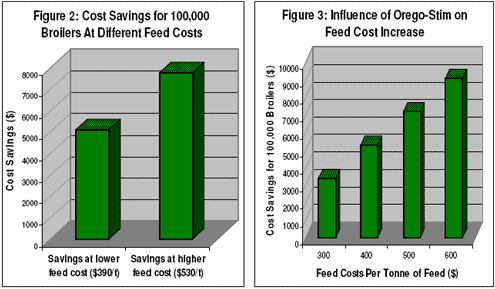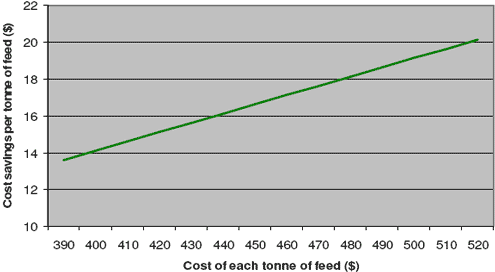



Why Should Orego-Stim Be Used When Feed Costs Are Increasing?
Orego-Stim, a phytogenic feed additive containing natural essential oils from Meriden Animal Health, can help broiler integrators worldwide not only to pull through these difficult economic times but to thrive and prosper. How it can do so is presented in Meriden's Technical Bulletin No. 22.The Escalating Cost of Feed
It is a common fact that livestock feed prices are now soaring sky high, be it in the European Union, Asia, South America, Africa or the United States. What is now known to be a global trend is all part and parcel of the perpetual law of supply and demand, where we are currently experiencing a decline of supply and an upsurge in demand. Last year, we have seen the prices of grain such as soybean, maize, wheat and barley increase by almost 70 per cent from 2006.
Across the globe, government and major livestock integrators attribute the hike in prices to the correspondingly rising prices of fuel. The price of crude oil has exceeded $130 per barrel and is expected to hit $200 by 2010, according to predictions by Goldman Sachs and various other economic analysts. Many nations have turned to agricultural crops for alternative energy, such as by utilising corn for bioethanol production. This has caused feed grain prices to escalate beyond control. It doesn’t help that the demand has also been high as well, driven by increasing global population growth and the growing affluence of some of the world's most populous nations. The world's population is currently believed to be just over 6.7 billion. In line with population projections, this figure continues to grow at rates that were unprecedented before the 20th century and on its current growth trajectory, is expected to reach approximately nine billion in just three decades from now. In China, the total consumption of pork, broiler meat and beef increased by 142 per cent over the past 18 years. This figure is significantly higher than the population increase of 16 per cent over that same time period. Other rising Asian economies such as India and Vietnam are headed in the same direction. Disappointing harvests in several of the world's key agricultural producing nations have also contributed to soaring agricultural prices. Bad weather and dismal crop yields caused by drought in Australia, frost in Argentina, lack of sun and too much rain in Europe, have all put a sharp pinch in the global production of everything from meat to grain last year.
All these factors in turn contribute to agriculture and livestock production becoming increasingly competitive. Smaller livestock producers have had to decrease their stocks to cut losses while others have had their operations ceased or completely shut down.
The Importance of Efficient Feed Conversion
The economics of feed conversion efficiency is one of the most important principles for a farmer to understand. The cost of feed claims approximately 75 per cent of the total budget for most livestock producers. Consequently, it is very important for producers to obtain the optimum performing diet for the most economical price.
Of course, how efficiently a meat-producing animal can convert feed to meat will play a crucial role in determining not only the viability but also the profits of the livestock producer. In the advent of the rising cost of feed globally, various strategies and health programmes have been planned and implemented to improve feed conversion efficiency to cut costs on feed and increase savings. Since the ban on antibiotic growth promoters (AGPs) in livestock animal feeds from January 2006, deciding just what goes into the feed for the money spent can get confusing with such a wide variety of feed additives available and varying prices for each of these additives. Having been created for the sole purpose of replacing the AGPs, most of these are new in the market and lack adequate research, efficacy trials and safety data. This can get even more confusing when one considers the varying feed conversion efficiencies promised by the various manufacturers of these additives.
Orego-Stim Improves Feed Efficiency
Orego-Stim is a phytogenic feed additive containing natural essential oils. When incorporated into livestock diets, Orego-Stim has been shown to improve feed conversion efficiency and growth rates. Extensive in vitro and in vivo trials have proven that Orego-Stim assists in alleviating problems associated with the presence of gastrointestinal pathogens such as E. coli, Salmonella spp., Clostridium perfringens and Eimeria spp. These pathogens are the leading cause of diarrhoea, weight loss and death in livestock animals, or alternatively poor performance that all lead to significant economic losses for livestock producers.
Based on a recent average of 10 separate broiler trials conducted in different countries around the world, Orego-Stim was found to improve the Feed Conversion Ratio (FCR), from an average of 1.88 to 1.79, which is a 4.86 per cent improvement.
The reduction of FCR through Orego-Stim is shown in Figure 1, whereby an FCR of 1.88 was considered the global industry average basis value. This calculation shows one of the many benefits of Orego-Stim in broiler production. All other parameters are constant, except the FCR, which is related to feed intake and therefore has an influence on feed savings. No further benefits were considered.

As shown in Table 1, total feed intake of broilers in the trial group with Orego-Stim® was reduced by 0.189 kg per bird, because of the FCR improvement from 1.88 to 1.79.
Table 2 shows the difference in cost savings due to reduced feed intake at two different price levels, based on an average poultry population of 100,000 birds.

The inclusion of Orego-Stim in both feeds with differing costs reduced the total feed costs per 100,000 broilers. Interestingly, as the cost of feed increases, the benefits of using Orego-Stim in the feed also increase significantly. It is clear from this example that while the cost of feed increased by 36 per cent, Orego-Stim consequently helped increase savings by 52 per cent!
The escalating cost of feed varies in different countries around the world but in general, feed prices are expected to continue its upward trend. Broiler farms have resorted to downsizing their populations to cut losses. With the usage of Orego-Stim this is not necessary. Figure 3 shows the influence of using Orego-Stim in relation to the increase of feed prices for 100,000 broilers. In terms of feed, Figure 4 shows the cost savings per tonne of feed based on increasing feed prices. The higher the feed prices, the more Orego-Stim helps to increase feed cost savings.


Conclusion
The increased use of agricultural crops for biofuel, world oil prices at over $130 a barrel, global population growth, climate change, loss of agricultural land to residential and industrial development and growing consumer demand in China and India have pushed up the price of grain and livestock feed, which is causing a food and feed crisis around the world.
It is thus crucial to investigate different ways to increase feed conversion efficiency and lower production costs. By improving feed conversion and increasing growth rates while keeping gastrointestinal diseases at bay, Orego-Stim helps poultry integrators worldwide not only to pull through these difficult times, but also to thrive and prosper. By adding Orego-Stim to livestock feed, we are taking full advantage of the better health it provides the birds to maximise their ability to convert feed into meat and profits. The higher the cost of feed, the more apparent and distinct the benefits of using Orego-Stim becomes, in terms of cost savings for the poultry farmer.
So while feed prices continue to rise globally, Orego-Stim effectively buffers this increase and helps the smart poultry integrator to increase his profits while others struggle to face the gloomy tide of affliction caused by these soaring feed prices.
July 2009








